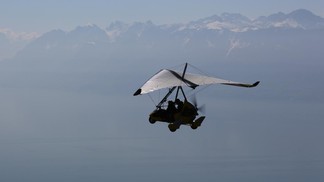Jun 3 2013
Ultra-light aircraft are being deployed in both Switzerland and Russia as part of the Léman-Baïkal project. Lake Geneva, the largest lake in the Alps, and Lake Baikal, the world’s largest lake, will be studied using new airborne analysis methods.
 © EPFL / Alain Herzog
© EPFL / Alain Herzog
Swiss and Russian scientists are pooling their scientific expertise to gain better understanding of lake environments. On board ultralight, technology-packed aircraft, they are testing new analysis methods above Lake Geneva and Lake Baikal. With the support of Ferring Pharmaceuticals and the Honorary Consulate of Russia in Lausanne, and with additional help from the Russian Academy of Sciences, the researchers will observe the surfaces of the two lakes from the air. The field campaign has just begun over Lake Geneva.
In a press conference held on May 14, 2013, the principal investigators unveiled the outlines of the international Léman-Baïkal project. On May 25, the ultralight aircraft will take off on a 7,500 km voyage to Russia. During the flight, EPFL scientists will use on-board technology to study biodiversity. French researchers from the CEA will join the crew for the trip to gain a better understanding of the atmospheric consequences of boreal forest fires. On June 24, the field campaign over Lake Baikal will begin.
Lakes Geneva and Baikal: similarities and differences
Lake Geneva and Lake Baikal have several things in common. Both glacial lakes are large enough to give rise to complex water circulation phenomena, and both are affected by human activity. They are also different enough that a comparison is of interest. Although Lake Geneva is huge for an Alpine lake, Lake Baikal is on another scale altogether. It’s the world’s largest body of fresh water, stretching more than 600 km in length and with a maximum depth of 1,600 meters. By testing their methods over these two bodies of water, the researchers have ideal conditions in which to develop new analysis methods geared for lake environments.
State-of-the-art scientific equipment
One of the ultralights is equipped with a hyperspectral camera that can separate the light spectrum into more than 250 parts. Using this, it becomes possible to see exactly how algae and suspended sediments are distributed and circulate in the layers that rise to the lake surface. The data from the planes will be combined with satellite data as well as water samples taken from a catamaran. Lidars will provide information on atmospheric flow near the surface of the lake.
River deltas are another important area of research interest. Sidestreams are often vectors of pollution, due to upstream human activity, and their discharge introduces complex flows known as “plumes” into the lake. By clarifying the complex dynamics of this phenomenon, the scientists hope to be able to better understand how pollutants spread. During the first exploration session in Russia, they will set their sights in particular on the plume from the Selenga River, in the delta that is incomparably larger than that of the Rhone River.
A platform for research exchange between Switzerland and Russia
In 2011, the elemo field campaign provided an opportunity for Swiss researchers to benefit from Russian technology and expertise. The MIR submersibles made an unprecedented exploration of the waters of Lake Geneva possible. This time, Switzerland will make an important contribution with analysis methods that have been developed at EPFL. “One of our goals is to share our expertise with our Russian colleagues, particularly in the area of hyperspectral imaging,” says EPFL’s Ulrich Lemmin, scientific director of the Leman-Baïkal project.
Another component of the Léman-Baïkal project is the establishment of a scientific exchange program. Switzerland and Russia will each send five scientists who will live in the partner country. These scientists will organize workshops to share their results, with the objective of publishing joint work in professional journals.
This adventure is made possible thanks to renewed funding from Ferring Pharmaceuticals. “In 2011, with the elemo campaign, we demonstrated our commitment to the Lake Geneva region and the protection of the lake environment,” explains Michel Pettigrew, President of the Executive Board of Ferring Phamaceuticals. “We are proud to renew our support of this project; it corresponds perfectly with Ferring’s fundamental values, which are centered on human beings, research and the sharing of knowledge.”